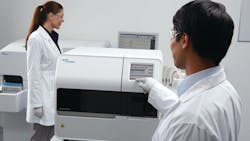Coagulation analysis became important for my family when my then 30-year-old cousin wound up in the emergency room with a double pulmonary embolism after a two-hour car ride. Medical professionals scrambled to figure out why a woman so young would be suffering from such a diagnosis; thus, coagulation analysis answered the question, revealing a genetic clotting mutation known as Factor V Leiden.
Had it not been for this nearly tragic event, my family would have never known to be tested for this condition, and it answered the question as to why so many in the family had various blood clots over the years – as well as why many women in the family did not have any children.
Clotting disorders
Factor V Leiden is a genetic mutation where people may develop blood clots very easily. This mutation can be either heterozygous (inherited from one parent) or homozygous (inherited from both parents), with the homozygous genetic factor putting patients at risk for blood clots when in bed too long without moving, something essential for healthcare providers to know about after surgeries, for example, during the recovery process.
“The Activated Protein-C Resistance assay, or APCR, is a common screening assay for Factor V-Leiden performed in the coagulation laboratory,” explained John G. Chromczak, MLS (ASCP)cm SHcm, Instrument Product Manager at Diagnostica Stago Inc. Some analyzers may require third-party APCR assays for screenings to determine if additional genetic testing is required. “Early detection of a Factor V-Leiden mutation by a healthcare provider may reduce the probability of a patient developing a thromboembolism through the prophylactic use of anti-coagulant medications.”
Public awareness about screening for clotting disorders, such as Factor V-Leiden and Lupus Anticoagulants/Antiphospholipid Syndrome, is becoming more prevalent as clinicians, laboratorians, and laboratory professionals educate patients and healthcare providers on the benefits of ordering these simple coagulation assays.
“Lupus Anticoagulants (LAs) may also cause a patient to develop blood clots; although, the name is counterintuitive. Testing for LAs involved a series of coagulation assays, such as: Stago’s STA DRVV (dilute Russel Viper Venom) Screen and Confirm assays; PTT-LA, a highly lupus anticoagulant aPTT assay; and Staclot LA, a hexagonal phase reagent that neutralizes a circulation LA. Screening for LAs in the coagulation laboratory have become more popular, due to more awareness about their effect on women’s health. If undiagnosed, LAs may cause a woman to experience multiple miscarriages and/or thromboembolisms,” added Chromczak.
In sharing with Chromczak about my family history, he added, “like you, I’ve had someone close to me who struggled for years with carrying a fetus to term, and it wasn’t until she was properly diagnosed that she was able to have another child. Women’s Health has such a long way to go in my opinion.” He shared a patient video describing the struggle: https://www.youtube.com/watch?v=B6qPRciOADs.
Blood thinners
Coagulation analysis can also be important for people taking blood thinning medications1, as some blood thinners require regular laboraotry monitoring to keep the patient in the proper therapeutic range. Warafin is one such drug. Abbott2 and Roche3 have home-use coagulation tests for INR, which is a prothrombin time based test.
“Direct oral anticoagulation (DOAC) may interfere with aPTT test results,” shared William M. Trolio, Vice President and Chief Scientific Officer at Bio/Data Corporation. Patients undergoing orthopedic procedures like knee or hip replacement surgery may be treated with heparin, Aspirin or Xarelto (rivaroxaban). Heparin therapy is monitored by aPTT test results. Aspirin therapy is often not monitored but can be followed with ADP and Arachidonic Acid induced platelet aggregation.
DOAC therapy is often used to the thrombotic risk in people that have pro-thrombotic conditions like Factor V Leiden.
“Contrary to the perception that DOAC does not affect haemostasis testing, most tests of haemostasis, including those commonly used to assess the prothrombotic status of a patient who has had a thrombotic event, are significantly affected by DOAC.” Trolio added 1 PT and APTT reagents are very in their sensitivity to DOAC agents.
Antiplatelet therapy, which includes drugs like Aspirin, clopidogrel (Plavix)1, Prasugrel (Effient), ticagrelor (Brilinta)and ticlopidine (Ticlid), is routinely used in patients who have had thrombotic or clot caused event, such a heart attack or stroke.
There is a simple, single test device, which can determine a patient’s ability to respond to clopidogrel (and similar drugs), based on the presence or absence of a genetic mutation ( CYP2C19*2). About 30 % of people cannot metabolize Plavix.
You need to know what the patient’s ability to respond to a drug in order to determine the proper medication choice and dose.
Coagulation analyzers do not discover genetic pathways, and some analyzers specifically analyze platelets. “Platelet functions affect more than hemostasis. They are involved in cancer, cancer treatment and metastasis, sepsis, autoimmune disorders, inflammatory responses and COVID 19,” explained Trolio.
He pointed out that people with high grade viruses usually have elevated D-dimer levels. “D-dimer is easy to order, but people don’t order platelet function studies as much as they should.”
Automation
Not all analyzers are created equal, as some smaller capacity models may not have the fully automated features of some of the larger bench models for optimum convenience. In Table 1, we compare analyzers for small, medium, and large sized labs.
Automation may be a bonus to some and a necessity to others. Lower volume labs might be fine with small, manual bench analyzers that perform basic laboratory testing, such as PT, aPTT, Fib and D-dimer. Intermediate labs may be interested in freestanding semi-automated analyzers that have a larger testing menu to include factor and hypercoagulation assays.
High volume labs may enjoy the convenience of fully automated floor model analyzers, especially when connected to a total laboratory automation system that will spin tubes to separate plasma. Fully automated systems are known for their high-throughput testing and reagent capacity to help the lab increase efficiency and turn-around-times.
“Table and floor models will pick up blood factors, but the little ones do not,” explained Trolio.
When comparing coagulation analyzers, some systems are optical based while others are both mechanical and optical based, depending on the assay type (clot based vs. chromogenic vs. immunoturbidometric). Trolio explained, “if it’s more sensitive, you can work up more patients. Both do the job, but both have bias.”
With so many different brands on the market, Trolio advises that you get what you pay for. “Smaller companies might not have the technical support that the bigger companies offer, or their systems may not be engineered as well as the larger companies. The larger companies get more data for clearance from the FDA.” Clearance from the U.S. Food and Drug Administration (FDA) does not guarantee the same performance as another brand.
For low volume labs, the Sysmex CA-104 and the Siemens BFT II would each have results within seconds of each other; just be familiar with bias and reference ranges for each.
Larger models have multiple technologies, such has having several wavelengths for coagulation, immunologic and enzymatic testing. Those are things the bench and table models might not do, and they may not connect with an LIS system; whereas, larger models may have the computer capability of connecting with LIS.
Models with a computer board, instead of a personal computer, may require changing a system upon upgrade. Embedding is a major change, as it allows for FDA notification. Some stand-alone models may still be using Windows 7 or 10. Trolio advises, “wait until the next generation of analyzers. If you buy one running on Windows 7, you might have five years. Newer models will have newer operating systems.”
Lab should consider
“A coagulation analyzer brings its greatest value to the laboratory when coupled with an extensive best-in-class reagent menu for both routine and specialty assays,” explained Chromczak. “Laboratories should determine the testing needs of their patient population based on healthcare provider ordering requests. The coagulation analyzer should support a robust testing menu to prepare for expanded testing needs. Reagent and consumable stability and quantity increase throughput and improve turn-around-times. Hands-on time required to maintain and run the analyzer should be aligned with the laboratory’s workflow and demand. Maintenance activities should be limited, and the system should provide full traceability for all end-user activities.”
“All available analyzers on the market are great systems,” explained Jason Lam, Sr. Marketing Product Manager, Siemens Healthineers; still, he advised there may be questions worth asking when purchasing coagulation analyzers, such as, “how are the analyzers helping the techs be efficient and mitigating erroneous results?”
If the ultimate goal is maximizing and increasing productivity, testing, accuracy and reliability, while decreasing diagnostic errors, another question worth asking is, “how easy is it to run QC on the analyzer, and is it fully automated?”
Take into consideration response time for on-site support, remote support through software application, as well as how it can improve customer satisfaction.
Lam added, “the labs really need to evaluate what challenges in their own labs need to be overcome, and how the right fit system helps mitigate those challenges and provide the best patient results and care.”
Table 1 4, 5, 6, 7
References
- University of Wisconsin Hospitals and Clinics Authority. Coagulation: Plavix VerifyNow Platelet Reactivity (PRU) test. UW Health. https://www.uwhealth.org/lab-test-directory/coagulation/name-125134-en.html. Accessed April 15, 2021.
- PT/INR CARTRIDGE. PT/INR Test Cartridge | Abbott Point of Care. https://www.pointofcare.abbott/us/en/offerings/istat/istat-test-cartridges/PT-INR. Accessed April 15, 2021.
- Diagnostics R. Roche introduces first self-testing device for Warfarin monitoring with built in Bluetooth technology. https://www.prnewswire.com/news-releases/roche-introduces-first-self-testing-device-for-warfarin-monitoring-with-built-in-bluetooth-technology-300662601.html. Published June 27, 2018. Accessed April 15, 2021.
- TEG 5000. TEG 5000 Thrombelastograph Hemostasis Analyzer System| Haemonetics. http://teg.haemonetics.com/en-gb/teg-5000-thrombelastograph. Accessed May 3, 2021.
- Hematology analyzers & systems. Hematology analyzers and systems | Abbott Core Laboratory. https://www.corelaboratory.abbott/us/en/offerings/category/hematology. Accessed May 3, 2021.
- ACL TOP Family 50 Series: Instrumentation Laboratory. ACL TOP Family 50 Series | Instrumentation Laboratory. https://www.instrumentationlaboratory.com/us/en/acl-top-family-50-series. Accessed May 3, 2021.
- cobas t 511 coagulation analyzer. Roche Diagnostics. https://diagnostics.roche.com/global/en/products/instruments/cobas-t-511.html. Accessed May 3, 2021.
About the Author
Marisa L. Williams
Editor
The author of more than 100 independently published books, Marisa L. Williams earned her Master’s at Johns Hopkins University, while interning on Capitol Hill, doing press and communications for the National Association of Community Health Centers. Creating her own Bachelor of Science degree at the University of Toledo, Williams blended pre-medical, pre-law, and laboratory studies, resulting in an interdisciplinary degree emphasizing Forensics. She has worked with Dr. Paulette Moulton (Levy), a dermatologist in Monroe, MI, as well as Dr. Elizabeth Triana, a family medicine practitioner specializing in hormone therapy, based out of Port Charlotte, FL; additionally, she has 20 years of experience as a multimedia journalist, is a third generation Realtor licensed in MI and FL, and has five years of college level teaching experience.


